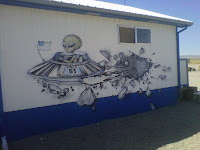Copyright 2010 by Gary L. Pullman
The Soviets took this picture of Area 51 from an orbiting satellite.
According to its website, Rachel, NV is home to 98 humans. The count of extraterrestrials, or aliens, is unknown. Rachel is also home to the A’Le’Inn, which serves ale (actually, hard liquor and beer) and boasts an inn of sorts (a group of trailers that vistors can rent for the night or longer). The name of the combination restaurant-bar-and-souvenir shop is a play on words. It is also the last local business in the town.
Situated alongside State Road 375 (“Extraterrestrial Highway”), Rachel is the nearest civilian community to Area 51, where top secret projects are conducted on behalf of the Air Force. It is rumored that some of this research may involve extraterrestrial spacecraft, or UFOs, many of which, people claim, have been sighted over the skies above Rachel.
Sorry, but I'm no videographer, especially while driving!
A friend of mine, Paula, and I made a recent trip to Rachel, to visit both the A’Le’Inn and to drive down Groom Lake Road to the signs that flank the entrance to the top secret facility.
The exterior of the front door and the front wall.
Outside the A’Le’Inn, an extraterrestrial visitor and his or her spacecraft, a UFO, are painted on the front wall, and the front door bears the message, “All Species Welcome.” A wrecker equipped with a crane supports a captured or recovered disc-shaped UFO. 20th Century Fox, the film studio that produced the movie Independence Day, donated a time capsule encased in or buried beneath a large block of stone. Behind the bar-restaurant-gift shop trailer are other trailers that, collectively, make up the “inn” portion of the A’Le’Inn.
The entrance side to the A'Le'Inn.
At the A’Le’Inn, my friend ordered an Alien Burger with cheese, and I ordered a green chili omelet and home fries, which came with buttered toast and home fries. Although we ate a late breakfast (or an early lunch; it was about 11:30 AM), we ordered diet Pepsis to wash down our respective meals. The food was fairly good, as was the service.
"Proof" that we are not alone!
The souvenir shop sells alien items of all kinds: tee shirts, ashtrays, banks, mugs, glasses, plaques, masks, and sundry other items. One wall bears numerous photographs of UFOs on a bulletin board sandwiched between the ladies’ room and the men’s room. An “Evidence Room” is decorated with a poster warning of the penalty (death) for trespassing. Also along the wall are three dummies tricked out to resemble aliens. Along the front wall, tee shirts and jackets are available for purchase. The front of the bar is painted with planets and suns protected by panels of Plexiglas.
Perusing a book for sale in the gift shop, I learned that the road to Area 51, Groom Lake Road, is situated about halfway between mile markers 34 and 35. Going back toward U. S. Highway 93, east from Rachel, one comes to mile marker 35 before mile marker 34. The marker is approximately 20 miles east of Rachel. Turning right (heading south) on Groom Lake Road from the Extraterrestrial Highway, one travels for approximately fifteen miles along the unusually wide, well-paved gravel road before reaching the warning signs that flank the road and mark the entrance to Area 51. On the way, one passes a couple of intersecting gravel roads and a lot of cacti and Joshua trees in the uneven desert terrain.
Maybe the source of the alien stories?
The signs have changed. In fact, the new ones have been placed over the old ones. The latter once warned that the installation commander had authorized personnel to shoot trespassers on sight. The newer signs have toned down the rhetoric considerably, warning only of a fine and/or a prison sentence for anyone who crosses the line into Area 51. (There is no gate, but one is apt to see the camouflage-uniformed security guards in their black reconnaissance vehicle atop a hill overlooking the boundary between civilian and military terrain, which is an eerie sight.)
Overall, my trip (actually, it’s my second) to Rachel and Area 51 (or the warning signs at its border, anyway) was enjoyable. However, it also deflates the mystique of the place. It’s not at all like Hollywood (or UFO fans) picture it. I mean, there’s not even a gate or an armed guard at the entrance to the place! If you plan a drive to Rachel, fill your gas tank in Ash Springs (60 miles east of Rachel) or Tonopah (110 miles northwest of Rachel). Otherwise, you might be walking . . . through alien territory!
Not really part of the A'Le'Inn, but everyone wants to get on the act. . . .















